Comparative Study on the Performance of Gel Grease for High-End Equipment Based on the Synergistic Effect of Friction-Reducing Agents
Abstract
1. Introduction
2. Results and Discussion
2.1. Tribological Performance Test
2.1.1. Tribological Properties of Schaeffler Load 460
2.1.2. Effect of PV611 on Tribological Properties of Greases
2.1.3. Effect of RFM3000 on Tribologs of Greases
2.1.4. Effect of Mixing PV611 with RFM3000 (3:1) on the Tribological Properties of Greases
2.1.5. Effect of Mixing PV611 with RFM3000 (1:1) on the Tribological Properties of Greases
2.1.6. Effect of Mixing PV611 with RFM3000 (1:3) on the Tribological Properties of Greases
2.1.7. Comparative Analysis of Tribological Experiments
2.2. Rheological Property Test
2.2.1. Comparative Analysis of Shear Stress
2.2.2. Comparative Viscosity Analysis
3. Conclusions
3.1. Conclusions
- (1)
- The average coefficient of friction of the experimental grease Schaeffler Load 460 was 0.11; with the addition of PV611, the coefficient of friction was reduced to 0.061; with the further addition of RFM3000, the coefficient of friction was further reduced to 0.045. The coefficients of friction for the different mixing ratios are shown as follows: the experimental grease with the addition of PV611 mixed with RFM3000 (3:1) was 0.047; the experimental grease with the (1:1) mixture was 0.044; and the experimental grease with the (1:3) mixture was the lowest at 0.032. These results show that the experimental grease using PV611 mixed with RFM3000 (1:3) significantly reduces the coefficient of friction in all test conditions.
- (2)
- In friction wear experiments, it was observed that the average wear spot diameter of the experimental grease for Schaeffler Load 460 was 0.673; with the addition of PV611, the wear spot diameter was reduced to 0.473; and with the further addition of RFM3000, the wear spot diameter was reduced to 0.516. The experimental results at different mixing ratios showed that the diameter of the abraded spot of the experimental grease with the addition of PV611 mixed with RFM3000 according to (3:1) was 0.373; the diameter of the abraded spot mixed according to (1:1) was 0.3; and the diameter of the abraded spot mixed according to (1:3) was the smallest, which was 0.266. These results show that the use of experimental grease mixed with PV611 and RFM3000 (1:3) was able to significantly reduce the diameter of the abrasive spots in all test conditions.
- (3)
- In the process of a shear rate increase from 0/s to 100/s, the experimental grease using PV611 mixed with RFM3000 (1:3) shows more obvious viscosity characteristics and greater shear stress, which makes it possible to maintain better viscosity characteristics in a high-temperature environment.
3.2. Future Perspectives
- (1)
- The tribological performance and rheological properties of the grease can be further optimized by continuously adjusting the mixing ratio of PV611 and RFM3000. In particular, it was found that the grease mixed with PV611 and RFM3000 (1:3) had the best performance in terms of reducing the coefficient of friction and the diameter of the wear spots in the experiments, and future studies can explore more precise mixing ratios to obtain superior performance.
- (2)
- The grease mixed with PV611 and RFM3000 (1:3) shows good viscosity characteristics and shear stress at high shear rates and high temperatures, which is especially important for high-end equipment such as bearings and gearboxes at high loads and high speeds. Future research can further verify its stability and durability under different temperature and pressure conditions to ensure its wide application in industrial and high-end equipment.
4. Materials and Methods
4.1. Laboratory Equipment and Materials
4.1.1. MRS-10G Friction and Wear Tester
4.1.2. MCR Rotational Rheometer
4.1.3. Selection of Grease and Additives
4.2. Experimental Program Design
4.2.1. Tribological Experimental Design
4.2.2. Rheological Experimental Design

| Test Methods | Test Parameters |
|---|---|
| Equipment model | MCR Rotational Rheometer |
| Shear strain range | 0.1%~100% |
| Shear rate range | 0.01 s−1~100 s−1 |
| Temp | 80 °C |
| Timing | 15 s |
Author Contributions
Funding
Institutional Review Board Statement
Informed Consent Statement
Data Availability Statement
Conflicts of Interest
References
- Xiang, X.; Ke, F. High-end equipment development task decomposition and scheme selection method. J. Syst. Eng. Electron. 2021, 32, 118–135. [Google Scholar] [CrossRef]
- Xiang, X.; Ya, D. Quality improvement method for high-end equipment’s functional requirements based on user stories. Adv. Eng. Inf. 2023, 56, 102017. [Google Scholar]
- Han, P.; Hai, Z. A Review of Research on Wind Turbine Bearings’ Failure Analysis and Fault Diagnosis. Lubricants 2023, 11, 14. [Google Scholar]
- Yang, T.; Wang, X. An inorganic-organic hybrid CQDs@PVP lubricant additive: Achieving low friction and wear in PEG and water. Friction 2024, 12, 2281–2297. [Google Scholar] [CrossRef]
- Raj, S.; Simon, T. Grease Performance Requirements and Future Perspectives for Electric and Hybrid Vehicle Applications. Lubricants 2021, 9, 40. [Google Scholar] [CrossRef]
- Tao, W.; Zhan, L. Impact of Boron Nitride Nanoparticles on the Wear Property of Lithium Base Grease. J. Mater. Eng. Perform. 2020, 29, 4991–5000. [Google Scholar]
- Han, P.; Song, L. Analysis of Wind Turbine Equipment Failure and Intelligent Operation and Maintenance Research. Sustainability 2021, 15, 8333. [Google Scholar]
- Torre, K.; Graaf, J. Hydrodynamic lubrication in colloidal gels. Soft Matter 2023, 38, 7257. [Google Scholar] [CrossRef]
- Hui, F.; Guo, Y. Graphene as a nanofiller for enhancing the tribological properties and thermal conductivity of base grease. RSC Adv. 2019, 72, 41984. [Google Scholar]
- Cheng, T.; Hong, X. A novel layered double hydroxides oleogel lubricant: Inspired by conventional greases. Tribol. Int. 2023, 187, 108746. [Google Scholar]
- Lu, H.; Yi, Y. Hydrogels for Lubrication: Synthesis, Properties, Mechanism, and Challenges. Lubricants 2024, 12, 186. [Google Scholar] [CrossRef]
- Han, P.; De, Z. The Optimization Study of Rheological Characteristics of Wind Power Grease Based on Gel-State. Gels 2024, 10, 253. [Google Scholar] [CrossRef]
- Ahmed, K.; Nemea, C. Bioinspired Lubricity from Surface Gel Layers. Langmuir 2024, 40, 9833–10404. [Google Scholar]
- Ya, W.; Jian, Y. A Janus hydrogel material with lubrication and underwater adhesion. Giant 2023, 16, 100186. [Google Scholar]
- Yi, L.; Jia, P. Study of the Effect of Continuous Thermal Effects on the Shear Stability of Magnetorheological Grease. Appl. Sci. 2023, 13, 13116. [Google Scholar] [CrossRef]
- Nan, X.; Wei, L. Reinforcing effect of Lewis acid–base interaction on the high-temperature colloidal stability and tribological performance of lubricating grease. J. Ind. Eng. Chem. 2017, 46, 157–164. [Google Scholar]
- Chun, W.; Wei, W. Study on Oil Distribution and Oil Content of Oil Bath Lubrication Bearings Based on MPS Method. Tribol. Trans. 2022, 65, 942–951. [Google Scholar]
- Han, P.; De, Z. Review of Wind Power Bearing Wear Analysis and Intelligent Lubrication Method Research. Coatings 2024, 14, 30. [Google Scholar]
- Xiao, L.; Yan, L. Preparation and tribological properties of solid-liquid synergetic self-lubricating PTFE/SiO2/PAO6 composites. Compos. Part B Eng. 2023, 196, 108133. [Google Scholar]
- Yong, C.; Xin, S. Tribological performance study of zirconium phosphate as an additive in titanium complex grease. Mater. Lett. 2022, 321, 132402. [Google Scholar]
- Hammad, Y.; Greg, C. Three dimensional (3D) percolation network structure: Key to form stable carbon nano grease. J. Appl. Res. Technol. 2016, 14, 6. [Google Scholar]
- Jia, R.; Hao, C. Study of the changes in the microstructures and properties of grease using ball milling to simulate a bearing shear zone on grease. Sci. Rep. 2024, 14, 9734. [Google Scholar]
- Tulika, B.; Chandra, P. Rheological investigation of the network structure in mixed gels of Kappa and Iota Carrageenan. Food Hydrocoll. 2024, 146, 109298. [Google Scholar]
- Peng, B.; Shao, L. Tribological properties of liquid-metal galinstan as novel additive in lithium grease. Tribol. Int. 2018, 128, 181–189. [Google Scholar]
- Hasan, B.; Onur, Ö. Tribological properties of MoS2 and CaF2 particles as grease additives on the performance of block-on-ring surface contact. Tribol. Int. 2022, 168, 107433. [Google Scholar]
- Wei, Y.; Chun, Z. Research on Mutual Synergy of Antiwear Additives in Lithium Complex Grease. Tribol. Trans. 2016, 59, 330–339. [Google Scholar]
- Soumya, S.; Md, R. Synergistic Study of Solid Lubricant Nano-Additives Incorporated in canola oil for Enhancing Energy Efficiency and Sustainability. Sustainability 2022, 14, 290. [Google Scholar]
- Mujtaba, M.A.; Cho, H.M.; Masjuki, H.H.; Kalam, M.A.; Farooq, M.; Soudagar, M.E.M.; Gul, M.; Ahmed, W.; Afzal, A.; Bashir, S.; et al. Effect of alcoholic and nano-particles additives on tribological properties of diesel–palm–sesame–biodiesel blends. Energy Rep. 2021, 7, 1162–1171. [Google Scholar] [CrossRef]
- Deepak, P.; Saurabh, T. Influence of MWCNTs, ZnO, and boric acid nanomaterial blend on the tribological and thermal properties of lithium grease. Tribol. Int. 2024, 192, 109197. [Google Scholar]
- Guan, R.; Chang, Z. Improving the rheological and tribological properties of lithium complex grease via complexing agent. Tribol. Int. 2022, 175, 107826. [Google Scholar]
- Ning, L.; Qing, C. Effect of hydroxyl functionalized ionic liquid additives on rheological and tribological properties of titanium complex grease. Tribol. Int. 2024, 193, 109416. [Google Scholar]
- Shi, L.; Chen, W. Synergistic effect of phosphorus based ionic liquids combined with nano two-dimensional α-ZrP on the tribological properties and mechanisms. Tribol. Int. 2024, 193, 109411. [Google Scholar]
- Yi, L.; Song, Z. Understanding the synergistic lubrication effect of 2-mercaptobenzothiazolate based ionic liquids and Mo nanoparticles as hybrid additives. Tribol. Int. 2018, 125, 39–45. [Google Scholar]
- Ananthan, T.; Deepkant, A. Influence of grease formulation parameters on the tribological property of rice bran oil based lubricating grease. J. Am. Oil Chem. Soc. 2021, 10, 769–778. [Google Scholar]
- Muharrem, T.; Rüstem, Y. Investigation of the effect of lubricant properties of carbon nanomaterial in Cu/MWCNT composites on wear. Front. Mater. 2023, 10, 3389. [Google Scholar]
- Han, P.; Hai, Z. Review of Tribological Failure Analysis and Lubrication Technology Research of Wind Power Bearings. Polymers 2022, 14, 3041. [Google Scholar] [CrossRef] [PubMed]
- Yu, S.; Yang, W. Study on anti-wear and friction-reducing compounding additives in lithium greases. Ind. Lubr. Tribol. 2023, 75, 5. [Google Scholar]
- Qian, Y.; Sha, L. Nitrogen-Phosphorus Codoped Carbon Nanospheres as Lubricant Additives for Antiwear and Friction Reduction. ACS Appl. Nano Mater. 2020, 171, 677. [Google Scholar]
- Qiang, H.; Zhi, W. Tribological properties of nanometer Al2O3 and nanometer ZnO as additives in lithium-based grease. Ind. Lubr. Tribol. 2018, 70, 6. [Google Scholar]
- Wei, Z.; Yu, T. Late-model N, B, and P-co-doped carbon dots as additives for friction-reduction and anti-wear. Diam. Relat. Mater. 2023, 139, 110315. [Google Scholar]
- Han, P.; Yan, L. Research on the optimization of tribological performance of wind power lubricating grease based on carbon emission. J. Eng. Res. 2023, 10, 1016. [Google Scholar]
- Ming, D.; Yi, M. Synergistic Effect of Acrylate of Dialkyl Dithiophosphoric Acid Combined with Molybdenum Dialkyl Dithiocarbamate as Additives in Gear Oil. Lubricants 2024, 12, 165. [Google Scholar] [CrossRef]
- Han, P.; Yi, C. Multi-Objective-Based Intelligent Lubrication System Performance Evaluation Technology for Construction Machinery. Appl. Sci. 2023, 13, 11768. [Google Scholar] [CrossRef]
- Jing, H.; Siavash, S. Synergistic Microgel-Reinforced Hydrogels as High-Performance Lubricants. ACS Macro. Lett. 2020, 9, 1726–1731. [Google Scholar]
- Wei, L.; Chanaka, K. Ultralow Boundary Lubrication Friction by Three-Way Synergistic Interactions among Ionic Liquid, Friction Modifier, and Dispersant. ACS Appl. Mater. Interfaces 2020, 171, 162. [Google Scholar]
- Hui, Z.; Shun, R. Revealing the tribological mechanism of synergistic effect between MoDTC and P-containing additives in aluminum-based grease. Ind. Lubr. Tribol. 2024, 12, 410. [Google Scholar]
- Yong, S.; Sheng, Y. Towards outstanding lubricity performance of proton-type ionic liquids or synergistic effects with friction modifiers used as oil additives at the steel/steel interface. Soft Matter 2024, 2, 296–452. [Google Scholar]
- Han, P.; Song, L. Research on the Rheological Characteristics of Wind Power Grease Based on Rheological Parameters. Lubricants 2023, 11, 299. [Google Scholar] [CrossRef]
- Sofi, S.M.; Abd Aziz, M.A.; Japar, N.A.; Rahman, N.A.; Abdulhalim, A.R.; Yunus, M.M. Preparation and characterization of grease formulated from waste transformer oil. IOP Conf. Ser. 2019, 702, 012034. [Google Scholar] [CrossRef]
- Milad, K.; Kevin, L. Artificial Intelligence (AI) for Sustainable Resource Management and Chemical Processes. ACS Sustain. Chem. Eng. 2024, 12, 8. [Google Scholar]
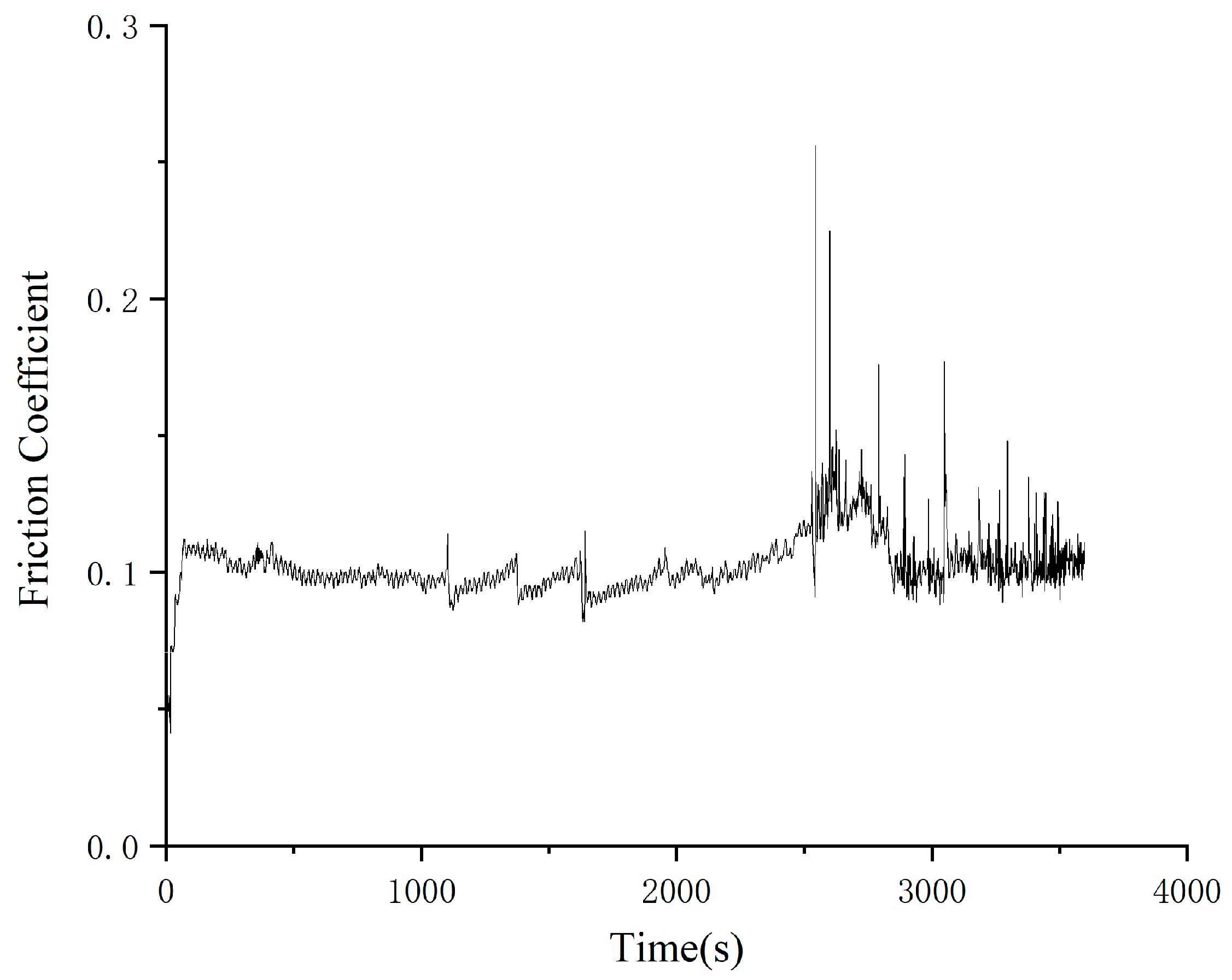


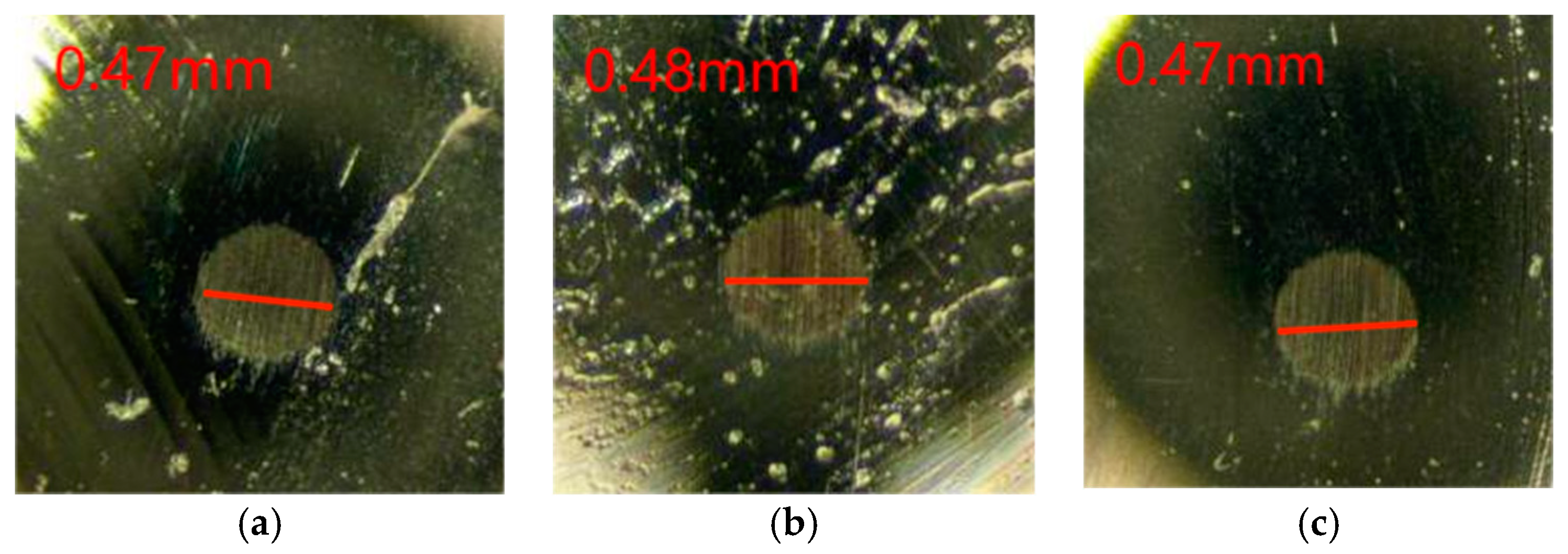
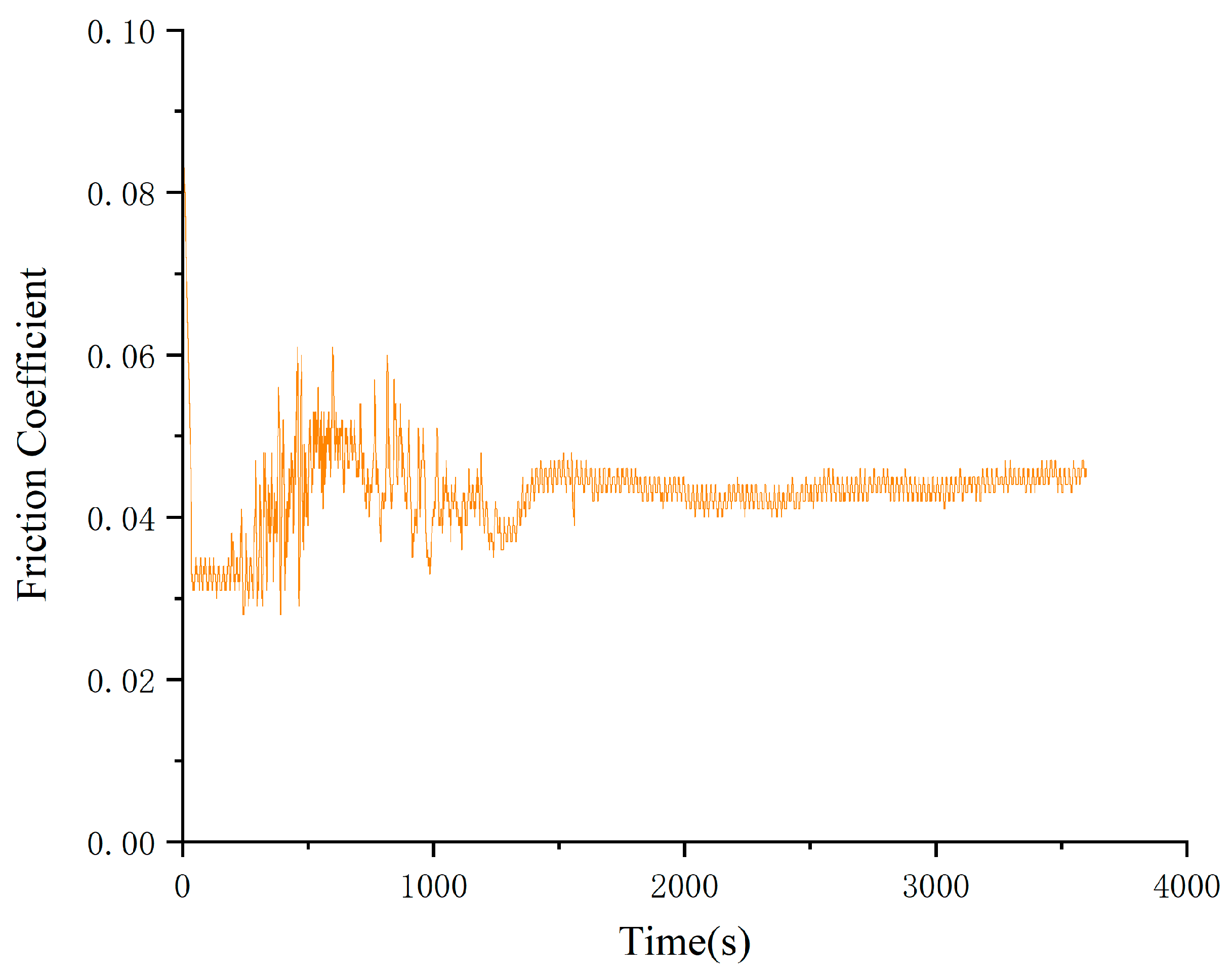

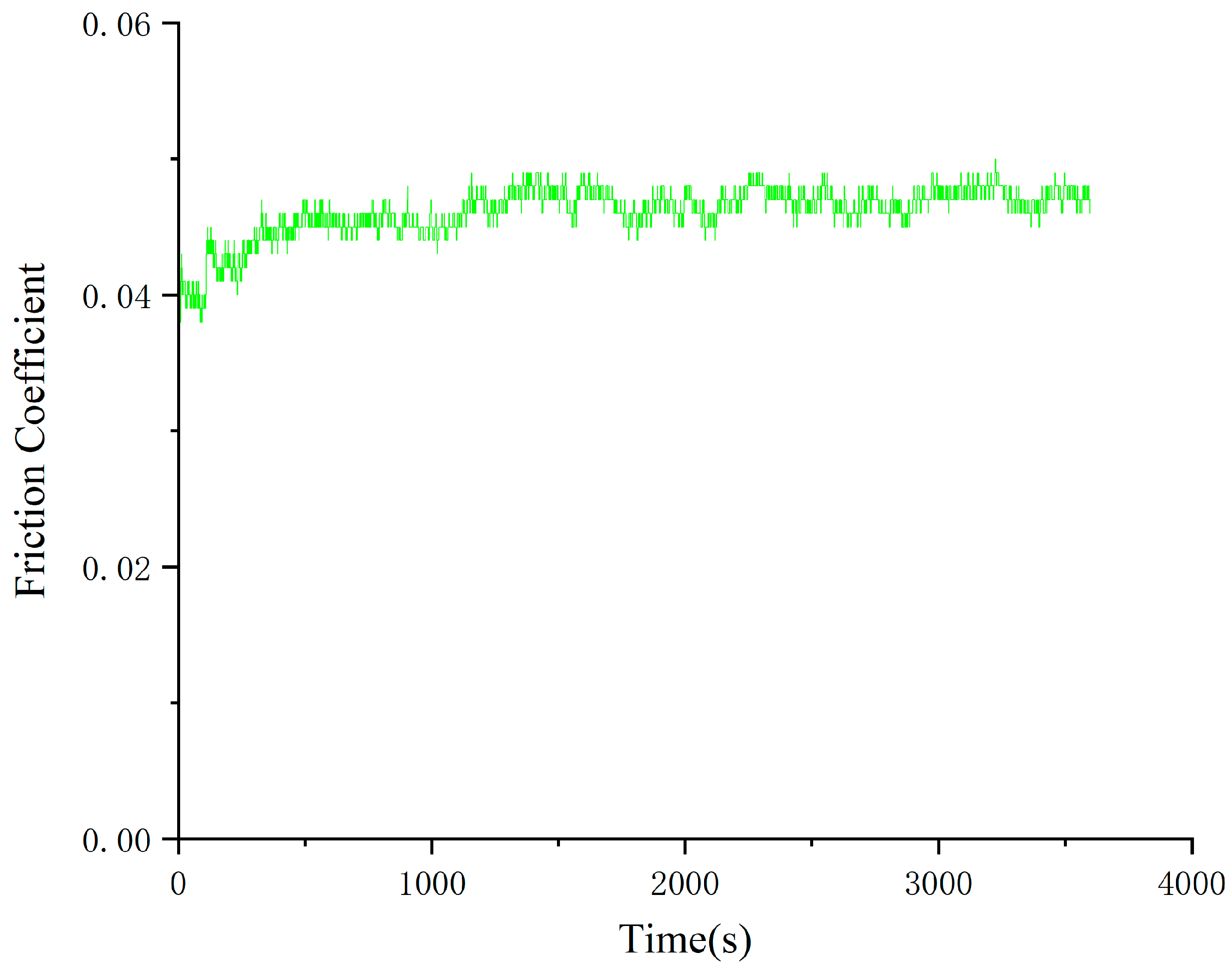
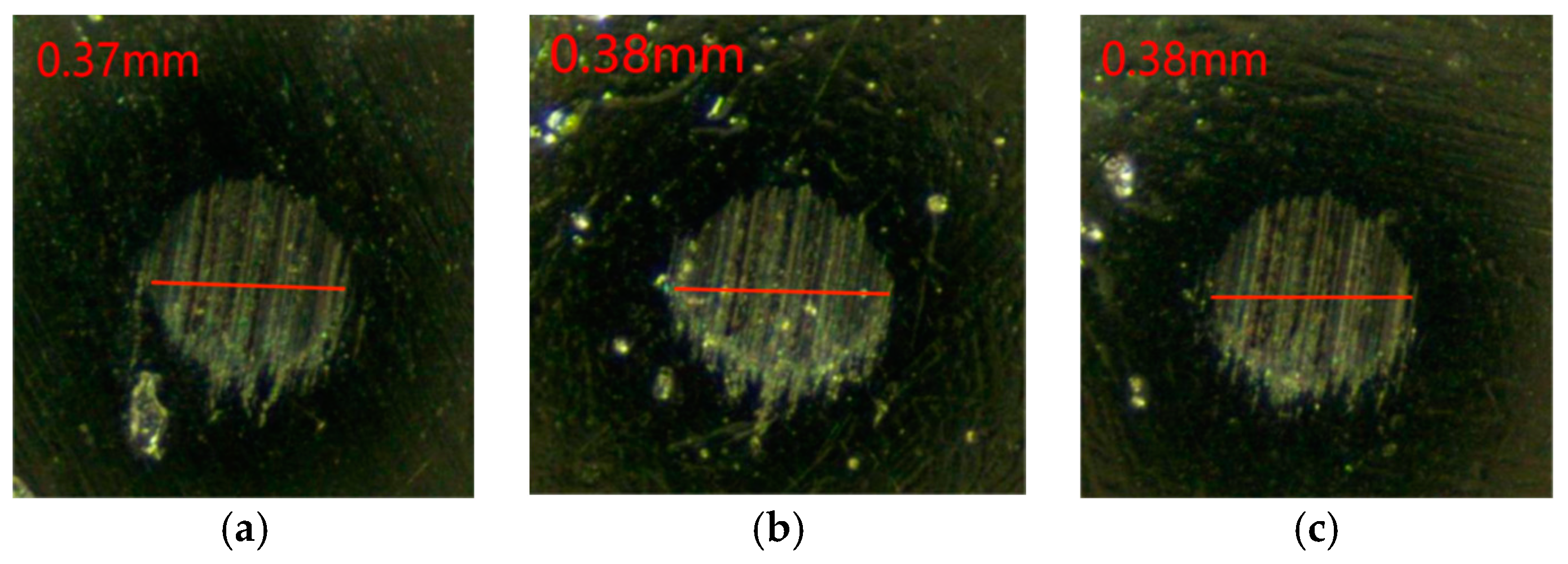

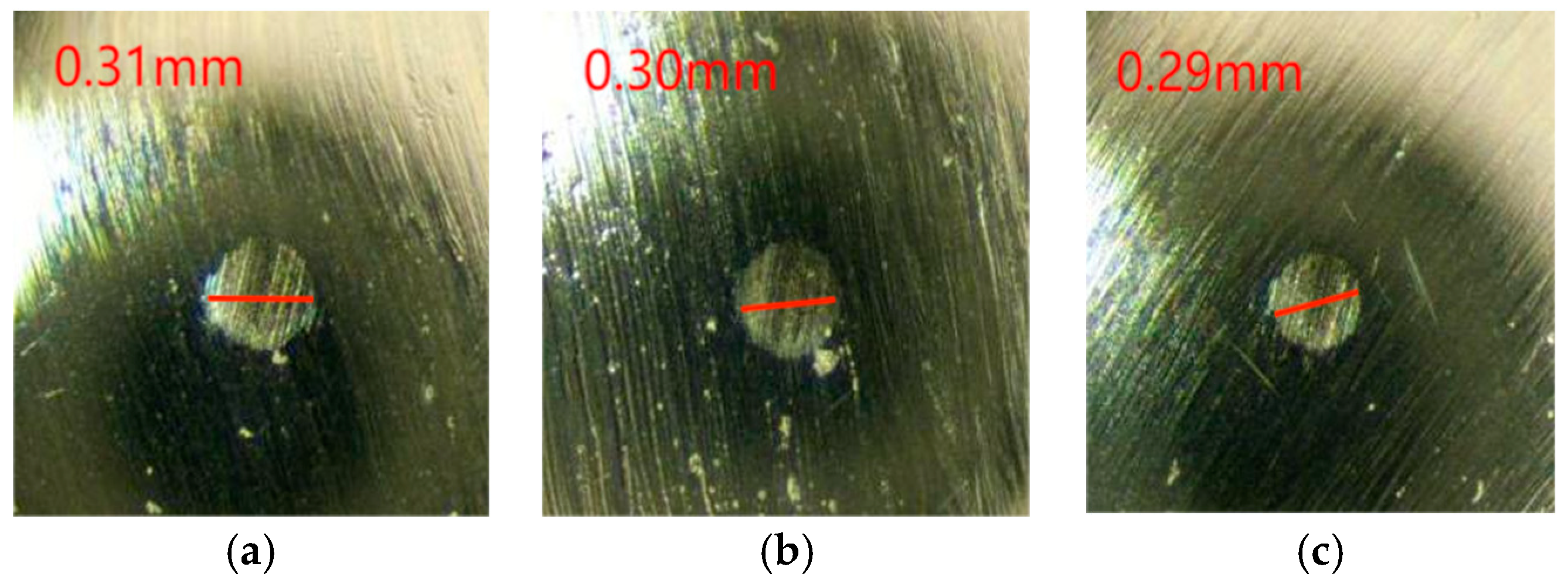


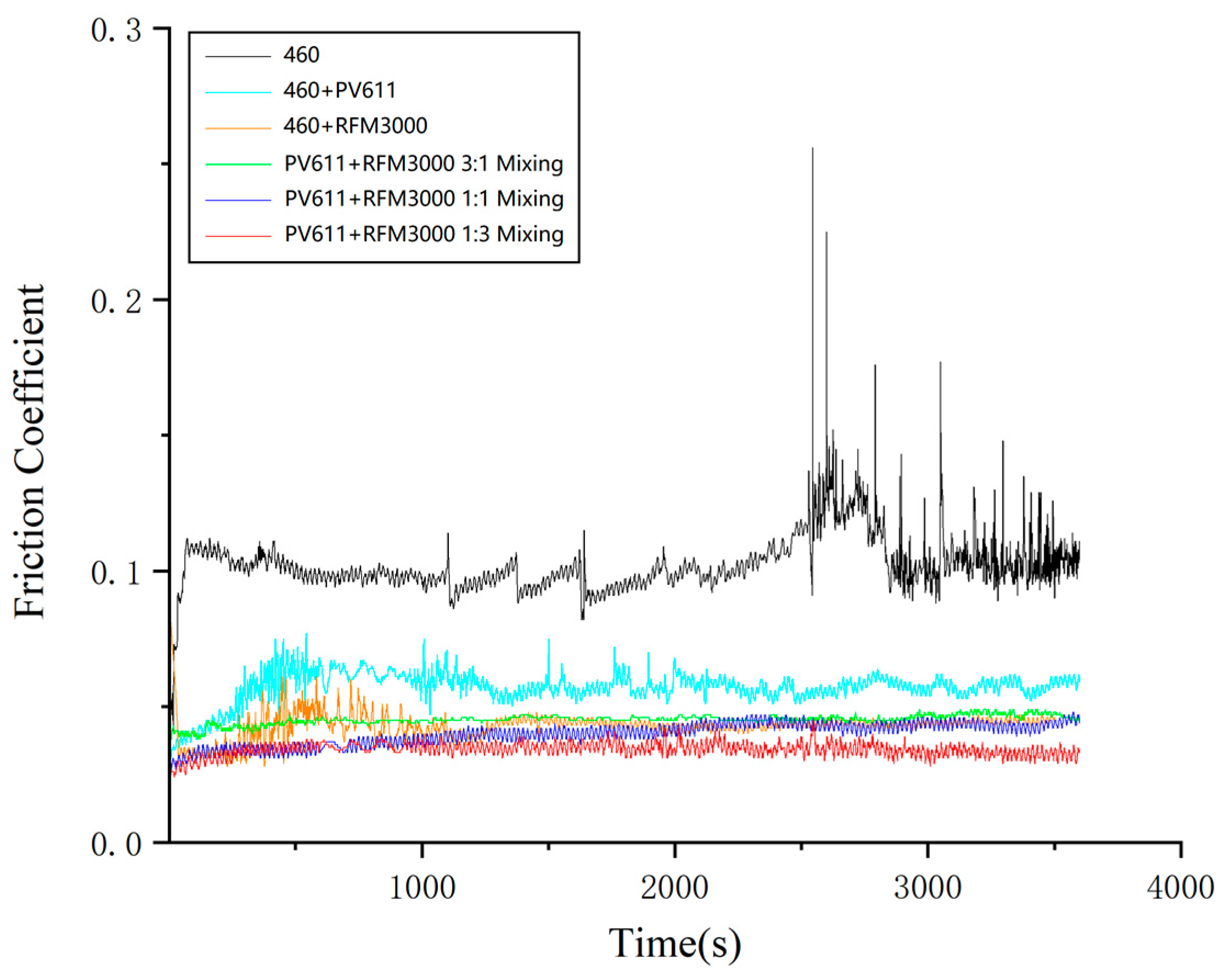

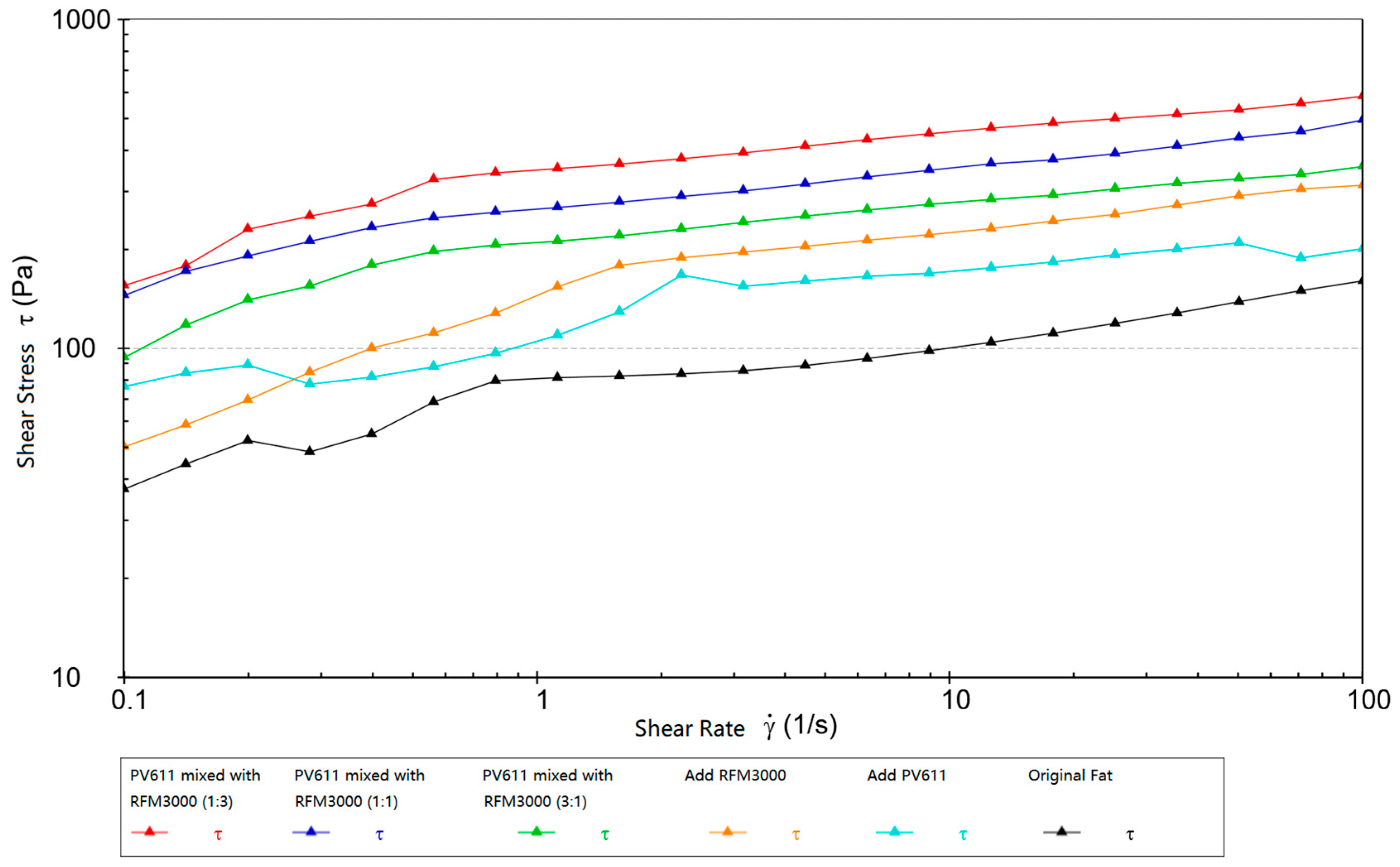
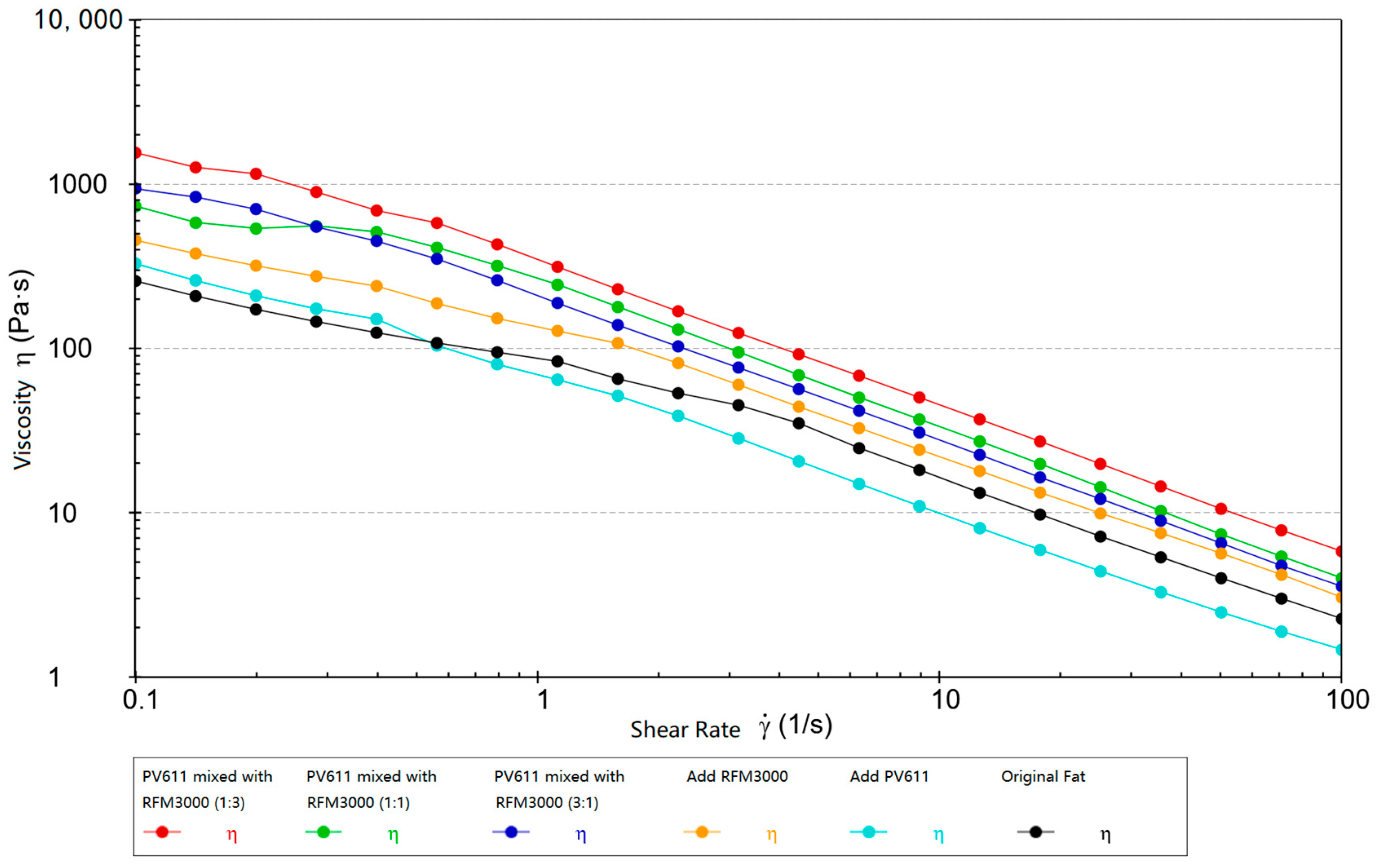

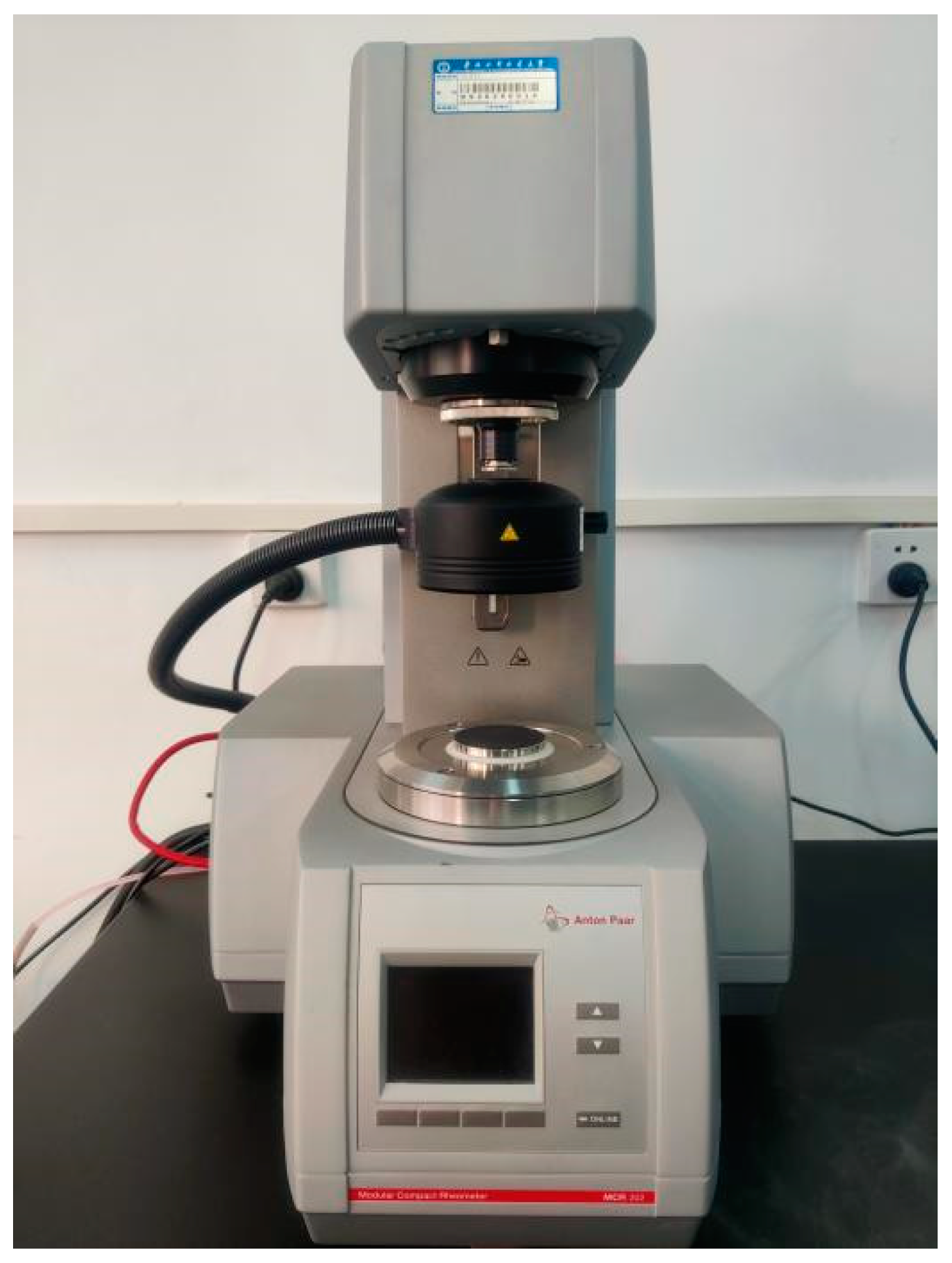


| Grease Grades | Base Oil Viscosity | NLGI Consistency Grade | Operating Temperature | Wear Resistance | Antioxidant Properties | Corrosion Resistance |
|---|---|---|---|---|---|---|
| Schaeffler Load 460 | 400 | 1 | −40 °C~130 °C | High | High | High |
| Test Methods | Test Parameters |
|---|---|
| Equipment model | MRS-10G Lever Type Four-Ball Friction Tester |
| Spindle speed | 1200 r/min |
| Temp | 80 °C |
| Payloads | 392 N |
| Timing | 3600 s |
Disclaimer/Publisher’s Note: The statements, opinions and data contained in all publications are solely those of the individual author(s) and contributor(s) and not of MDPI and/or the editor(s). MDPI and/or the editor(s) disclaim responsibility for any injury to people or property resulting from any ideas, methods, instructions or products referred to in the content. |
© 2024 by the authors. Licensee MDPI, Basel, Switzerland. This article is an open access article distributed under the terms and conditions of the Creative Commons Attribution (CC BY) license (https://creativecommons.org/licenses/by/4.0/).
Share and Cite
Peng, H.; Li, Y.; Shangguan, L.; Chen, Y.; Zhang, N. Comparative Study on the Performance of Gel Grease for High-End Equipment Based on the Synergistic Effect of Friction-Reducing Agents. Gels 2024, 10, 573. https://doi.org/10.3390/gels10090573
Peng H, Li Y, Shangguan L, Chen Y, Zhang N. Comparative Study on the Performance of Gel Grease for High-End Equipment Based on the Synergistic Effect of Friction-Reducing Agents. Gels. 2024; 10(9):573. https://doi.org/10.3390/gels10090573
Chicago/Turabian StylePeng, Han, Yanchi Li, Linjian Shangguan, Yike Chen, and Nannan Zhang. 2024. "Comparative Study on the Performance of Gel Grease for High-End Equipment Based on the Synergistic Effect of Friction-Reducing Agents" Gels 10, no. 9: 573. https://doi.org/10.3390/gels10090573
APA StylePeng, H., Li, Y., Shangguan, L., Chen, Y., & Zhang, N. (2024). Comparative Study on the Performance of Gel Grease for High-End Equipment Based on the Synergistic Effect of Friction-Reducing Agents. Gels, 10(9), 573. https://doi.org/10.3390/gels10090573






